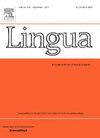The effects of linguistic proximity on dependency distance and dependency direction of translated English from 35 languages
IF 1.3
3区 文学
0 LANGUAGE & LINGUISTICS
引用次数: 0
Abstract
As the “third code”, translated language differs from native language in terms of syntactic features. Translations from different source languages can exhibit syntactic variation due to the source language shining-through effect. This study investigates the impact of linguistic proximity on dependency distance and dependency direction of translated English from various source languages. A corpus of native English and translated English from 35 languages was constructed and annotated for analysis. The findings are: (1) Compared to native English, translated English from 17 languages exhibits shorter mean dependency distances (MDD), while translations from 18 languages exhibit longer MDD. Translations from 13 languages are more head-final, while translations from 22 languages are more head-initial. (2) The dependency distance of translated English correlates positively with the linguistic proximity between source language and English, while the clustering of dependency directions is associated with the linguistic proximity of source languages within language families. (3) For languages spoken in countries where English is an official language alongside the native language, the dependency distance and dependency direction of translated English are influenced more by English than by the native language. These differences arise because dependency distance reflects the cognitive demand involved in processing dependency relations, whereas dependency direction functions as a typological marker distinguishing languages.
语言接近度对35种语言翻译英语依赖距离和依赖方向的影响
翻译语言作为“第三码”,在句法特征上不同于母语。由于源语言的闪过效应,不同源语言的译文会出现句法上的差异。本研究探讨了语言接近性对不同源语言翻译英语依赖距离和依赖方向的影响。构建了35种语言的母语英语和翻译英语语料库,并对其进行了注释以供分析。研究发现:(1)与母语英语相比,17种语言翻译的英语平均依赖距离(MDD)较短,而18种语言翻译的英语平均依赖距离(MDD)较长。来自13种语言的翻译更多的是头尾,而来自22种语言的翻译更多的是头首。(2)翻译英语的依赖距离与源语与英语的语言接近度呈正相关,而依赖方向的聚类与语系内源语的语言接近度呈正相关。(3)在英语为官方语言和母语的国家,翻译英语的依赖距离和依赖方向受英语的影响大于受母语的影响。这些差异的产生是因为依赖距离反映了处理依赖关系所涉及的认知需求,而依赖方向则是区分语言的类型标记。
本文章由计算机程序翻译,如有差异,请以英文原文为准。
求助全文
约1分钟内获得全文
求助全文
来源期刊

Lingua
Multiple-
CiteScore
2.50
自引率
9.10%
发文量
93
审稿时长
24 weeks
期刊介绍:
Lingua publishes papers of any length, if justified, as well as review articles surveying developments in the various fields of linguistics, and occasional discussions. A considerable number of pages in each issue are devoted to critical book reviews. Lingua also publishes Lingua Franca articles consisting of provocative exchanges expressing strong opinions on central topics in linguistics; The Decade In articles which are educational articles offering the nonspecialist linguist an overview of a given area of study; and Taking up the Gauntlet special issues composed of a set number of papers examining one set of data and exploring whose theory offers the most insight with a minimal set of assumptions and a maximum of arguments.
 求助内容:
求助内容: 应助结果提醒方式:
应助结果提醒方式:


